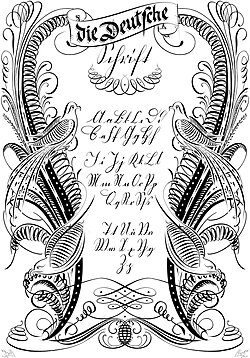Social:Kurrent
Kurrent (German: [kʊˈʁɛnt]) is an old form of German-language handwriting based on late medieval cursive writing, also known as Kurrentschrift ("cursive script"), deutsche Schrift ("German script"), and German cursive. Over the history of its use into the first part of the 20th century, many individual letters acquired variant forms.
German writers used both cursive styles, Kurrent and Latin cursive, in parallel: Location, contents, and context of the text determined which script style to use.
Sütterlin is a modern script based on Kurrent that is characterized by simplified letters and vertical strokes. It was developed in 1911 and taught in all German schools as the primary script from 1915 until the beginning of January 1941. Then it was replaced with deutsche Normalschrift ("normal German handwriting"), which is sometimes referred to as "Latin writing".
Lettering examples
Letter from Lessing to Kleist, 14 March 1758
See also
- Antiqua–Fraktur dispute
- Blackletter
- Fraktur (script)
References
External links
- German handwriting Schrift (in German) Overview and examples of Kurrent by N. A. Powell
- German language page about Kurrent, with history of German cursive handwriting and Kurrent
- Another version, by Lars Erik Bryld, called Manu Gothica
- Yet another version, by Peter Wiegel
- Kurrent-Schreibmaschine – Old German typewriter An online assistant for better reading Kurrent
In German Wikipedia
- Eszett (letter ß)
- Sütterlin handwriting
- Grundschrift handwriting
 |













